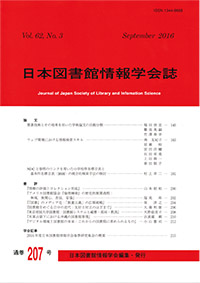Volume 51, Issue 2
Displaying 1-7 of 7 articles from this issue
- |<
- <
- 1
- >
- >|
Article
-
Article type: Article
2005 Volume 51 Issue 2 Pages 49-61
Published: June 15, 2005
Released on J-STAGE: May 04, 2017
Download PDF (1298K) -
Article type: Article
2005 Volume 51 Issue 2 Pages 62-74
Published: June 15, 2005
Released on J-STAGE: May 04, 2017
Download PDF (1397K)
Report
-
Article type: Report
2005 Volume 51 Issue 2 Pages 75-98
Published: June 15, 2005
Released on J-STAGE: May 04, 2017
Download PDF (2487K) -
Article type: Report
2005 Volume 51 Issue 2 Pages 99-
Published: June 15, 2005
Released on J-STAGE: May 04, 2017
Download PDF (78K) -
Article type: Report
2005 Volume 51 Issue 2 Pages 100-
Published: June 15, 2005
Released on J-STAGE: May 04, 2017
Download PDF (77K) -
Article type: Report
2005 Volume 51 Issue 2 Pages 101-102
Published: June 15, 2005
Released on J-STAGE: May 04, 2017
Download PDF (111K) -
Article type: Report
2005 Volume 51 Issue 2 Pages 103-
Published: June 15, 2005
Released on J-STAGE: May 04, 2017
Download PDF (35K)
- |<
- <
- 1
- >
- >|
